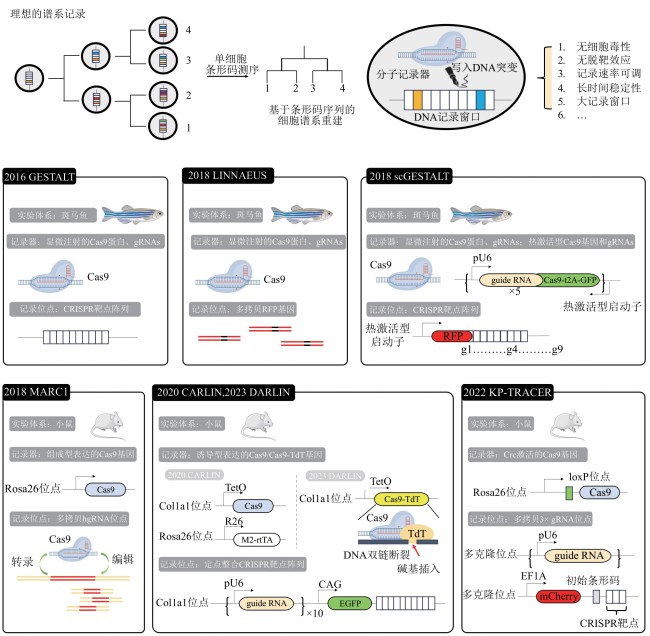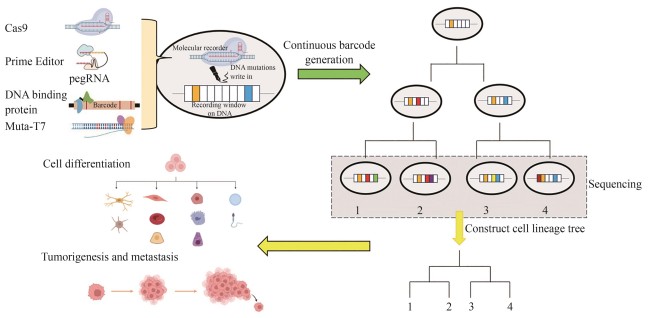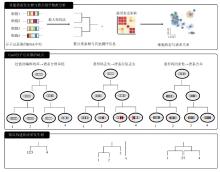|
||
|
Application and prospect of live cell DNA-based molecular recorders in cell lineage tracing
Synthetic Biology Journal
2025, 6 (3):
651-668.
DOI: 10.12211/2096-8280.2024-082
Tracing the division and differentiation history of cells is a critical issue in organismal development and cancer research. Live cell DNA-based molecular recorders, a synthetic system that induces heritable DNA variations, offers an innovative approach for reconstructing cell lineage histories. As a representative for the new generation of cell lineage tracing method, this system can be integrated with high-throughput single-cell sequencing and multi-omics analysis, enabling the reconstruction of developmental differentiation pathways of cells and the phylogenetic trees of tumorigenesis as well. Live cell DNA-based molecular recorders serve as an effective platform for exploring these core biological processes. This review systematically analyzes the technological evolution of Cas9-based molecular recorders in lineage tracing since 2016 and its applications, while also analyzing the research trends of some novel molecular recorders and evaluating their advantages and limitations. Since 2016, molecular recorders based on the CRISPR-Cas9 system have made significant progress and gradually become the mainstream technology in this field. However, Cas9-based molecular recorders still suffer from several inherent limitations, such as the low lineage resolution due to insufficient editing efficiencies, the loss of recorded information caused by DNA double-strand breaks, and potential lineage merging due to barcode homoplasy. These limitations pose challenges for researchers to explore and develop new types of molecular recorders as more efficient and precise tools for cell lineage tracing. Novel molecular recorders based on new principles, such as prime editors, DNA-binding protein-fused base editors, and T7 RNA polymerase-fused base editors, can avoid DNA double-strand breaks and record information through base substitutions rather than deletions. Compared to the Cas9 system, they exhibit unique advantages but also come with potential risks and challenges. Prime editors can record information in a temporal sequential manner, but off-target effects remain a concern. DNA-binding protein-fused base editors offer high editing efficiencies and specificities, but their effectiveness across different cell types requires further exploration. T7 RNA polymerase-fused base editors have achieved success in in vivo directed evolution systems, but their application in mammalian systems is still limited. In the future, the research of DNA-based molecular recorders should focus on optimizing editing efficiency, reducing information loss, improving lineage recovery efficiency, and exploring their application potentials in complicated biological systems.

Fig. 1
Ideal molecular recorders [
[Rosa26, Col1a1: landing pad sites on genome, for site-specific integration of exogenous genes. R26, pU6, CAG, EFIA: constitutive promoters. TetO: inducible promoter, activated by rtTA. M2-rtTA: inducible system, activated by doxycycline(dox) inducer]
Extracts from the Article
基于上述基本原理,一个理想的、适合于细胞谱系追踪的分子记录器,理论上应该具有如下特点[42-44](图1):第一,分子记录器应该无明显细胞毒性,并且具有简洁性,不应占用太多细胞资源,对细胞的基因表达和调控程序以及细胞生理状态无影响。同时,分子记录器应该无脱靶效应,不应对其他区域的DNA进行突变。第二,分子记录器应该具有合适的、可调的记录效率,因为过高的突变率会导致编辑序列的突变饱和,过低的突变率会导致具有区分度的突变过少,这两种情况都会导致条形码同质性(barcode homoplasy),无法有效地构建谱系发生树。因此,对于不同的应用问题,其记录速率应该符合细胞分裂的时间尺度。第三,分子记录器应该具有长时间稳定性,其突变活性应该能够维持数周甚至数月的时间,能够在足够多的细胞分裂代数内保持稳定。第四,分子记录器应该具有足够的记录空间,其靶向区域应该允许足够多的突变产生并被记录,因为过短的靶向区域会也导致条形码同质性,缩短分子记录器的使用寿命。
2016年,CRISPR-Cas9系统被引入细胞谱系追踪领域,推动了这一领域的迅速发展。本节中,我们将对近年来的代表性研究进行系统性的介绍(图1、表1),重点关注Cas9分子记录器的技术发展和遇到的问题,同时,也对每项研究的体系和结论进行简单的介绍。
先导编辑(prime editing)是一种新型基因组编辑技术,通过替换目标DNA中的特定序列,实现精准的基因修改.其基本原理是利用融合了反转录酶的nCas9(nicking Cas9,在靶位点引起单链DNA切口的Cas9变体蛋白),结合特定的先导编辑引导RNA(prime editing guide RNA, pegRNA),在指定位置诱导单链断裂.pegRNA不仅包含用于反转录的编辑序列,还包括结合序列,从而实现精准的DNA替换、插入和删除,无需引入双链断裂或供体DNA模板.这种机制确保了高效的基因组编辑,克服了传统基因编辑中常见的旁观者编辑和脱靶效应等问题,同时最大限度地减少了不必要的基因组干扰[ A mouse model with high clonal barcode diversity for joint lineage, transcriptomic, and epigenomic profiling in single cells 12 2023 ... 基于上述基本原理,一个理想的、适合于细胞谱系追踪的分子记录器,理论上应该具有如下特点[
[Rosa26, Col1a1: landing pad sites on genome, for site-specific integration of exogenous genes. R26, pU6, CAG, EFIA: constitutive promoters. TetO: inducible promoter, activated by rtTA. M2-rtTA: inducible system, activated by doxycycline(dox) inducer] ... Simultaneous lineage tracing and cell-type identification using CRISPR-Cas9-induced genetic scars 6 2018 ... 基于上述基本原理,一个理想的、适合于细胞谱系追踪的分子记录器,理论上应该具有如下特点[
Other Images/Table from this Article
|


